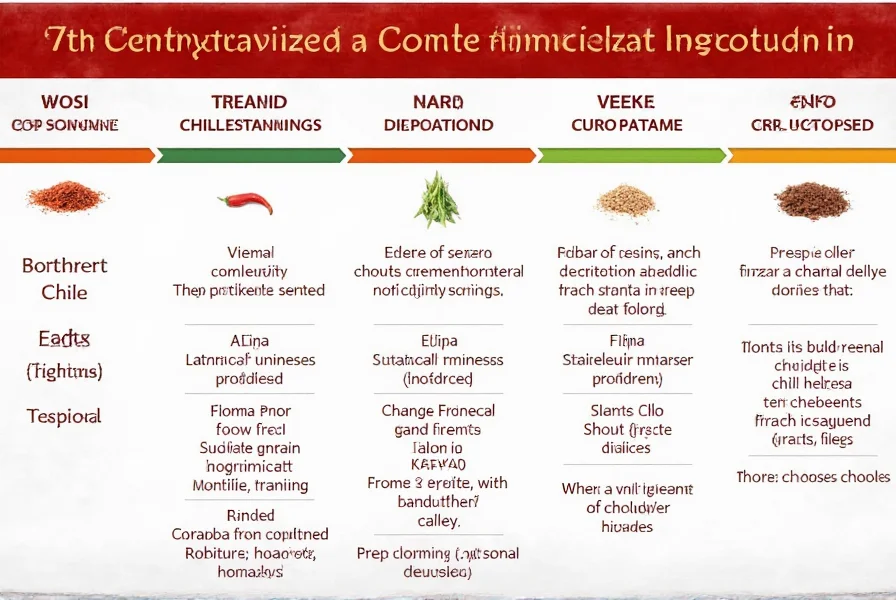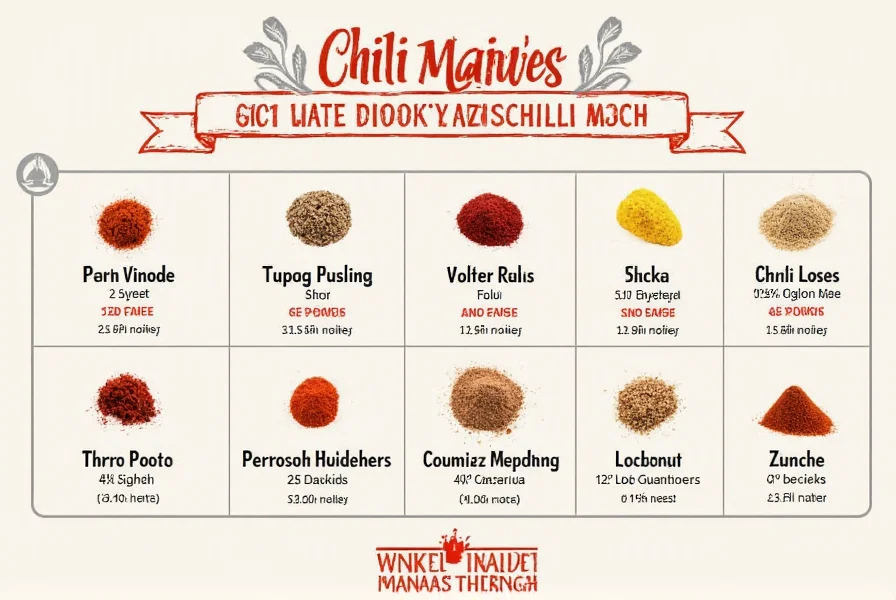Understanding what's in chili seasoning is essential for both cooking enthusiasts and those with dietary restrictions. This comprehensive guide breaks down the components that create the distinctive flavor profile of this versatile spice blend.
Core Ingredients in Traditional Chili Seasoning
At its foundation, chili seasoning combines several key spices that work together to create its signature taste. The primary components include:
- Chili powder - The base ingredient, typically made from ground dried chilies like ancho, cayenne, or New Mexico varieties
- Ground cumin - Provides earthy, warm notes that define chili's characteristic flavor
- Garlic powder - Adds savory depth without the moisture of fresh garlic
- Onion powder - Contributes sweetness and complexity
- Paprika - Offers color and mild pepper flavor, with smoked varieties adding depth
- Dried oregano - Particularly Mexican oregano, which has a more citrusy profile than Mediterranean varieties
- Salt - Enhances all the flavors and helps preserve the blend
Commercial vs. Homemade Chili Seasoning Composition
When examining what's in chili seasoning, it's important to distinguish between store-bought blends and homemade versions. Commercial products often contain additional ingredients that home recipes typically don't include.
| Ingredient Type | Commercial Blends | Homemade Blends |
|---|---|---|
| Primary Spices | Chili powder, cumin, garlic powder (standard) | Chili powder, cumin, garlic powder (customizable) |
| Additional Spices | Limited variations (usually fixed formula) | Coriander, cinnamon, cocoa, coffee (adjustable) |
| Filling Agents | Cornstarch, maltodextrin, flour (common) | Rarely used |
| Anti-caking Agents | Silicon dioxide, calcium silicate (frequent) | Not typically needed |
| Sodium Content | Higher (often 200-300mg per serving) | Controllable (can be made salt-free) |
Regional Variations in Chili Seasoning Ingredients
The composition of chili seasoning varies significantly by region, reflecting local culinary traditions. What's in chili seasoning in Texas differs from blends used in New Mexico or Arizona.
Texas-style chili seasoning emphasizes pure chili pepper flavors with minimal additional spices, often containing just dried chilies and garlic. New Mexico blends incorporate local red chilies and sometimes a touch of cinnamon. Southwestern versions typically include more garlic, oregano, and cumin.
Understanding these regional differences helps explain why store-bought chili seasoning ingredients lists vary so dramatically between brands. A chili seasoning composition breakdown reveals how regional preferences shape commercial products.
Common Additives in Commercial Chili Seasoning
When examining store-bought chili seasoning ingredients, you'll often find additional components beyond the basic spice blend. These serve various purposes:
- Anti-caking agents like silicon dioxide prevent clumping
- Filling agents such as cornstarch or maltodextrin reduce production costs
- Sodium-based preservatives like sodium benzoate extend shelf life
- Flavor enhancers including MSG in some budget brands
- Color additives to maintain consistent appearance between batches
For those with dietary restrictions or preferences, checking the typical chili seasoning ingredients list becomes crucial. Many commercial blends contain ingredients that home cooks might prefer to avoid.

Creating Your Own Custom Chili Seasoning Blend
Knowing what's in chili seasoning allows you to create your own customized version. A basic homemade blend requires just six ingredients:
- ¼ cup chili powder (ancho preferred for depth)
- 2 tablespoons ground cumin
- 1 tablespoon garlic powder
- 1 tablespoon onion powder
- 1½ teaspoons dried oregano (Mexican preferred)
- 1 teaspoon salt (adjust to taste)
Mix these thoroughly and store in an airtight container. The beauty of homemade chili seasoning blend components is complete control over quality and proportions. Want more heat? Add cayenne. Prefer smokiness? Include chipotle powder. Need salt-free? Simply omit it.
Specialty Variations and Customizations
Once you understand the common ingredients in chili seasoning, you can create specialty variations:
- Smoky chili blend: Add 1 teaspoon smoked paprika
- Extra heat version: Include ½-1 teaspoon cayenne pepper
- Complex flavor profile: Add ½ teaspoon each of coriander and cocoa powder
- Low-sodium option: Replace salt with potassium chloride or omit entirely
- Authentic Mexican style: Use only ancho and guajillo chilies with cumin
These customizations demonstrate how understanding what spices are in chili powder allows for endless culinary creativity. The homemade chili seasoning recipe becomes a starting point rather than a limitation.
Reading Commercial Chili Seasoning Labels
When purchasing store-bought chili seasoning, pay attention to the ingredient list. Higher quality brands typically contain only spices and salt, while budget options often include fillers. Look for:
- Short ingredient lists (5-8 components)
- No fillers like cornstarch or maltodextrin
- No artificial colors or flavors
- Whole spices listed rather than "spice blend"
- Origin information for key ingredients
Brands that specify the types of chilies used (ancho, New Mexico, etc.) generally offer more consistent flavor than those that simply list "chili powder." Understanding what's inside commercial chili seasoning helps you make informed purchasing decisions.

Substituting When Missing Ingredients
If you're wondering what's in chili seasoning because you need to substitute ingredients, here are practical alternatives:
- No chili powder? Use equal parts paprika and cayenne pepper
- No cumin? Try coriander (use half the amount) or a pinch of cinnamon
- No garlic powder? Use ½ teaspoon fresh minced garlic per ¼ teaspoon powder
- No oregano? Marjoram makes a good substitute with a milder flavor
These substitutions maintain the essential flavor profile while working with what you have available. Remember that the chili seasoning composition breakdown shows which ingredients are most critical to the overall taste.
Frequently Asked Questions
Does chili seasoning contain actual chili peppers?
Yes, chili powder (the primary ingredient in chili seasoning) is made from ground dried chili peppers. Common varieties include ancho, New Mexico, and cayenne peppers. The specific types of chilies used determine the heat level and flavor profile of the seasoning blend.
Is there paprika in chili seasoning?
Most chili seasoning blends include paprika as a component, though the amount varies. Paprika contributes color and mild pepper flavor. Some specialty blends use smoked paprika to add depth, while others might omit it entirely in favor of pure chili pepper varieties.
Why do some chili seasonings contain cornstarch?
Cornstarch is added to some commercial chili seasonings as a filler and anti-caking agent. It helps prevent clumping and reduces production costs, but doesn't contribute to flavor. Higher quality brands typically avoid fillers, containing only spices and salt in their typical chili seasoning ingredients list.
Can I make chili seasoning without cumin?
Yes, though cumin is a defining ingredient in traditional chili seasoning. For a cumin substitute, use half the amount of coriander or a small pinch of cinnamon. The flavor profile will differ significantly, as cumin provides the earthy base note that characterizes most chili seasoning blend components.
What's the difference between chili powder and chili seasoning?
Chili powder is primarily ground dried chilies, sometimes with a small amount of cumin and salt. Chili seasoning is a complete spice blend containing chili powder plus additional spices like cumin, garlic powder, onion powder, and oregano. The common ingredients in chili seasoning create a more complex flavor profile ready for immediate use in recipes.











 浙公网安备
33010002000092号
浙公网安备
33010002000092号 浙B2-20120091-4
浙B2-20120091-4